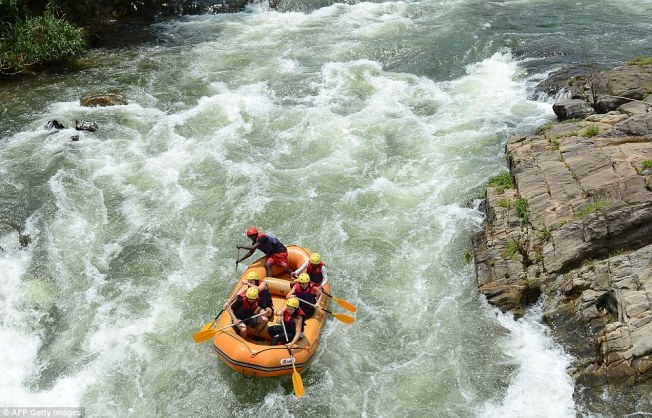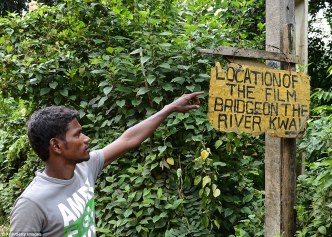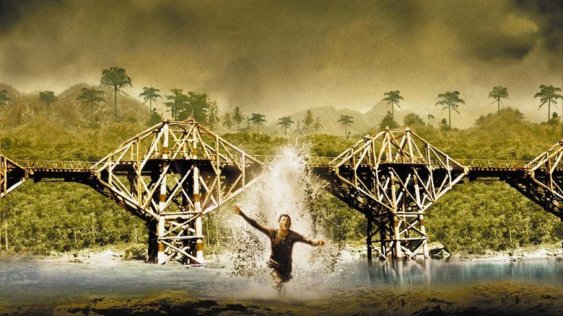 Woosh! and I am gasping for breath and clinging on to the side of the raft, a thin wiry fellow from the back is the hero who deftly manures the raft into a safe landing, having braved the rapids through the narrow gorge known as the Devil’s fault.
Woosh! and I am gasping for breath and clinging on to the side of the raft, a thin wiry fellow from the back is the hero who deftly manures the raft into a safe landing, having braved the rapids through the narrow gorge known as the Devil’s fault.
Kithulgala is a small wet town in Kegalle district. Enjoying the benefit of two monsoon rains it was once one of the wettest places in the island boasting of rain forests and a gushing rivulet that cuts across the ravines to join Kelani River. Climate change and dwindling rainfall has seriously affected the landscape. In addition the construction of a hydro-electric project further uphill by CEB is restricting the water flow of the tributary. This has resulted in other smaller rivulets in the area drying up.
A popular watering hole found little past the 44th kilometer point along the Awissawela-Hatton route (A7) is a dainty white Walawwa or bungalow by the name of Kithul Villa. Although we reached the place in roughly two hours covering over 80 kilometers from Colombo city, we were told that the water levels were too low for rafting. At the bungalow we were shown to a small stream that the local people use for bathing. There we found a quiet spot to dip in the cool water of a natural pool where we could sit on large stones and lend our feet to the nibbling of small fishes. Also the locals had placed the bark of a Kithul tree to direct the flow of the water into a make-shift shower (peella) that allowed us to bathe. The boys teased the girls saying that leeches are found in abundance when bathing in a peella, the leeches would suck blood until them were too full to cling on to the skin and then drop off. The girls squealed frightfully and I think a few leeches curdled at the sound they emitted. We remained there for a long while trying to discern the different bird calls. The evasive Emerald Green Dove made a startling appearance, forgetting our presence, been utterly shy flew away into the forest minutes later.
Then we got news of the water been released from the dam and made a move to the rafting spot. These were a bunch of new adventurers who transported us in several tuk-tuks to the starting point. Due to the low level of water we were going to try only three of the five rapids found on the journey. We would start at the mouth of the biggest cascade known as the Butter Crunch. We were suited with life jackets and helmets and given an oar each. At the water’s edge before boarding the raft we were taught the preliminaries of rafting – how to paddle forward, backward, relax and hold the rope and get into the boat. Each boat had a guide we liked to call our heroes since they are experienced in tackling the rapids.
The two boats – one red (Red Indians) and the other yellow (Bandits) were secretly named by the only juvenile aboard took off with the blowing of a whistle. We paddled in rhythm to get closer to the first one of the falls, and then furiously to meet up with the rapids. The Kithulgala rushed downwards throwing the canoe sideways and narrowly escaping been toppled. As I look back to ensure all my mates were still aboard, the wiry boy at the back was bent backwards like an arrow swerving the boat into a safe landing. We passed on placid water now flowing gently over a glassy lake, the scenery was breathtaking with tall mountains emerging in view and on either sides of the river bank was thick forest. Flocks of swallows (locally known as Wahi Lihiniya) were seen hovering in circles and rising up excitedly – their call is supposed to premonition rainfall. Unlike in the elusive rain forest of Sinharaja many rare and beautiful birds can easily be seen in Kithulgala.
Kithulgala is famous for the filming of ‘The Bridge over River Kwai’ in 1957. A special bridge is said to have been constructed for the film on World War 2 and blown up during the final scenes as the train was crossing the river. They left nothing behind other than the concrete foundations for us to remember this epic film.
 The sound of rushing water cautioned us of the next rapid known as the Devil’s Fault which we faced with bravery that would shame any marine. Having cleared that we rowed awhile to get through the Rib Cage that nearly throttled us between two large ridges, the water rose half a foot inside the boat and we were soaked to the skin. Beneath the suspended bridge we were tossed out of the boats to swim at leisure. The water was ten feet deep according to the skipper. I found the life jackets helpful to keep afloat. We drifted a while downstream and finally piled into the raft again to reach the end point. The trail ends at the Plantation hotel having covered 5 kilometers along the river. To make the ride memorable we grabbed the camera for a final shot of the entire team including the two boys who guided the rafts – our heroes.
The sound of rushing water cautioned us of the next rapid known as the Devil’s Fault which we faced with bravery that would shame any marine. Having cleared that we rowed awhile to get through the Rib Cage that nearly throttled us between two large ridges, the water rose half a foot inside the boat and we were soaked to the skin. Beneath the suspended bridge we were tossed out of the boats to swim at leisure. The water was ten feet deep according to the skipper. I found the life jackets helpful to keep afloat. We drifted a while downstream and finally piled into the raft again to reach the end point. The trail ends at the Plantation hotel having covered 5 kilometers along the river. To make the ride memorable we grabbed the camera for a final shot of the entire team including the two boys who guided the rafts – our heroes.
Just two hours’ drive from Colombo, Kithugala is a wonderful place to enjoy a day-trip. Apart from water-rafting, there are a myriad of other adventure sports, hiking and bird watching made available. While you are there don’t forget to taste authentic Jaggery and Treacle made from the Kithul tree that is found in abundance in this sleepy town, whose name is also derived from the very same tree.
